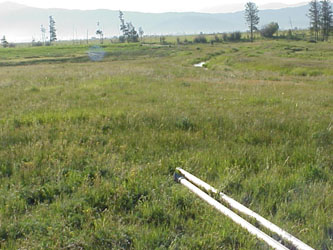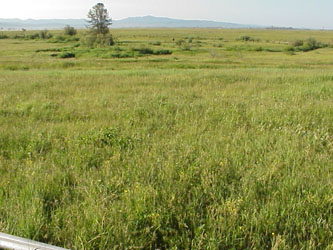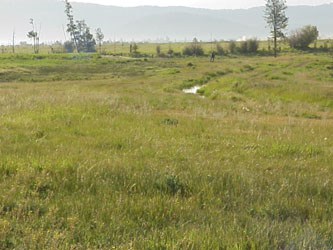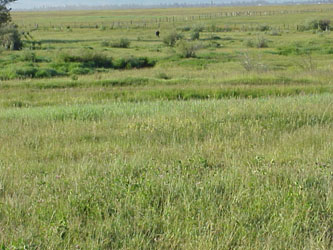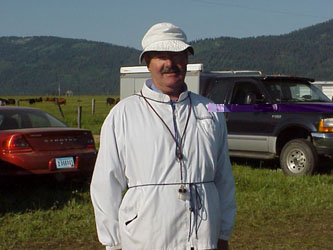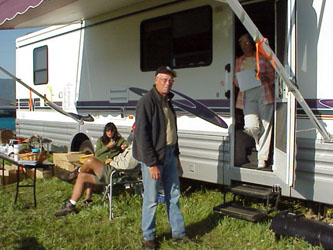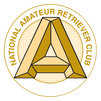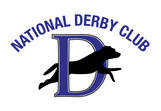Monday, June 16, 2003 |
Another clear, bright day greeted participants. It was in the mid fifty's with little wind. A haze hung over the meadows creating a heavy dew . A nearly full, pearlescent moon hovered in the sky over the silhouetted mountains beneath
The tests , # 2 and #3 were a pair of blinds. The left was a water blind; the right designated a land blind set up in the same field used for the previous marks. The line rested on top the same hill, a bit to the right. The left one was run first. Handlers were told they could only move laterally, not forward.
Again, test dogs arrived on line at 7:30 with the first running dog, #27 appearing at 8 a.m. Variable winds angled from left to right across the blinds. At first there was nearly no wind and the birds hard to scent. Handlers boxed their entrants around it until they could wind it. Later the wind rose and the birds could be winded, but dogs were less likely to get into/cross the flowing irrigation on the left blind.
To recover the left (water) blind dogs had to angle down the hill and across the ditch, then go up on land, across the dike road on a line nearly parallel to the ditch, then angle across the ditch for a second time. Beyond, the line nearly paralleled the far side of the bank to the bush were the hen pheasant lay, about 208 yards away. Dogs would angle down to the channel, then square it and come out too far to the right. A quick handle was needed in many cases. Others wanted to return to the previous day's flyer that was on the right. The crates still remained in position. A cast to the left was also a cast into the wind and water. That invited dogs to run down the dike road, refusing the cast to put them back on line. A red ribbon marked a point formed by the winding channel. Speculation was the it either marked the line to the bird or a dog should be on one side or the other. However, the true line crossed that "point" There were numerous cast refusals.
The right blind was also down the slope, to the right side of the previous day's mark. It continued through the ditch and a small piece of water behind right side of the holding blind. From there it went between a pair of medium sized bushes to the field beyond where the hen pheasant also was marked by a small bush 137 yards from line. It was in the same field where many hunts had occurred the day before. This blind seemed to present a "picture" to the dogs of what was expected and they dutifully took the casts to the bird. There were numerous whistles to keep them on line, but there was less trouble than on the left. Later a trail developed and aided a number of dogs to stay on line to the blind.
The combined test took about 6 mpd and the ETA time was approx. 4 p.m. If it finished early enough, another test was being organized a short distance away.
By mid afternoon it became apparent that the combined series would take longer than expected. It was then announced that no other test would be run today.
The combined series was completed about 5 p.m. when dog 25 returned to line.
About 7:15 call backs arrived. Eleven had been dropped. Those lost were: 13, 32, 34, 48, 57, 59, 64, 65, 82, 94, and 100. Test dogs would run at 7:30. First running dog, #52, at 8 a.m.
The bad news is that a forecast for severe weather was issued for Tuesday. Temperatures were expected to hit 100 degrees with severe thunderstorms. Your Tuesday report may be a bit later.
The tests , # 2 and #3 were a pair of blinds. The left was a water blind; the right designated a land blind set up in the same field used for the previous marks. The line rested on top the same hill, a bit to the right. The left one was run first. Handlers were told they could only move laterally, not forward.
Again, test dogs arrived on line at 7:30 with the first running dog, #27 appearing at 8 a.m. Variable winds angled from left to right across the blinds. At first there was nearly no wind and the birds hard to scent. Handlers boxed their entrants around it until they could wind it. Later the wind rose and the birds could be winded, but dogs were less likely to get into/cross the flowing irrigation on the left blind.
To recover the left (water) blind dogs had to angle down the hill and across the ditch, then go up on land, across the dike road on a line nearly parallel to the ditch, then angle across the ditch for a second time. Beyond, the line nearly paralleled the far side of the bank to the bush were the hen pheasant lay, about 208 yards away. Dogs would angle down to the channel, then square it and come out too far to the right. A quick handle was needed in many cases. Others wanted to return to the previous day's flyer that was on the right. The crates still remained in position. A cast to the left was also a cast into the wind and water. That invited dogs to run down the dike road, refusing the cast to put them back on line. A red ribbon marked a point formed by the winding channel. Speculation was the it either marked the line to the bird or a dog should be on one side or the other. However, the true line crossed that "point" There were numerous cast refusals.
The right blind was also down the slope, to the right side of the previous day's mark. It continued through the ditch and a small piece of water behind right side of the holding blind. From there it went between a pair of medium sized bushes to the field beyond where the hen pheasant also was marked by a small bush 137 yards from line. It was in the same field where many hunts had occurred the day before. This blind seemed to present a "picture" to the dogs of what was expected and they dutifully took the casts to the bird. There were numerous whistles to keep them on line, but there was less trouble than on the left. Later a trail developed and aided a number of dogs to stay on line to the blind.
The combined test took about 6 mpd and the ETA time was approx. 4 p.m. If it finished early enough, another test was being organized a short distance away.
By mid afternoon it became apparent that the combined series would take longer than expected. It was then announced that no other test would be run today.
The combined series was completed about 5 p.m. when dog 25 returned to line.
About 7:15 call backs arrived. Eleven had been dropped. Those lost were: 13, 32, 34, 48, 57, 59, 64, 65, 82, 94, and 100. Test dogs would run at 7:30. First running dog, #52, at 8 a.m.
The bad news is that a forecast for severe weather was issued for Tuesday. Temperatures were expected to hit 100 degrees with severe thunderstorms. Your Tuesday report may be a bit later.

